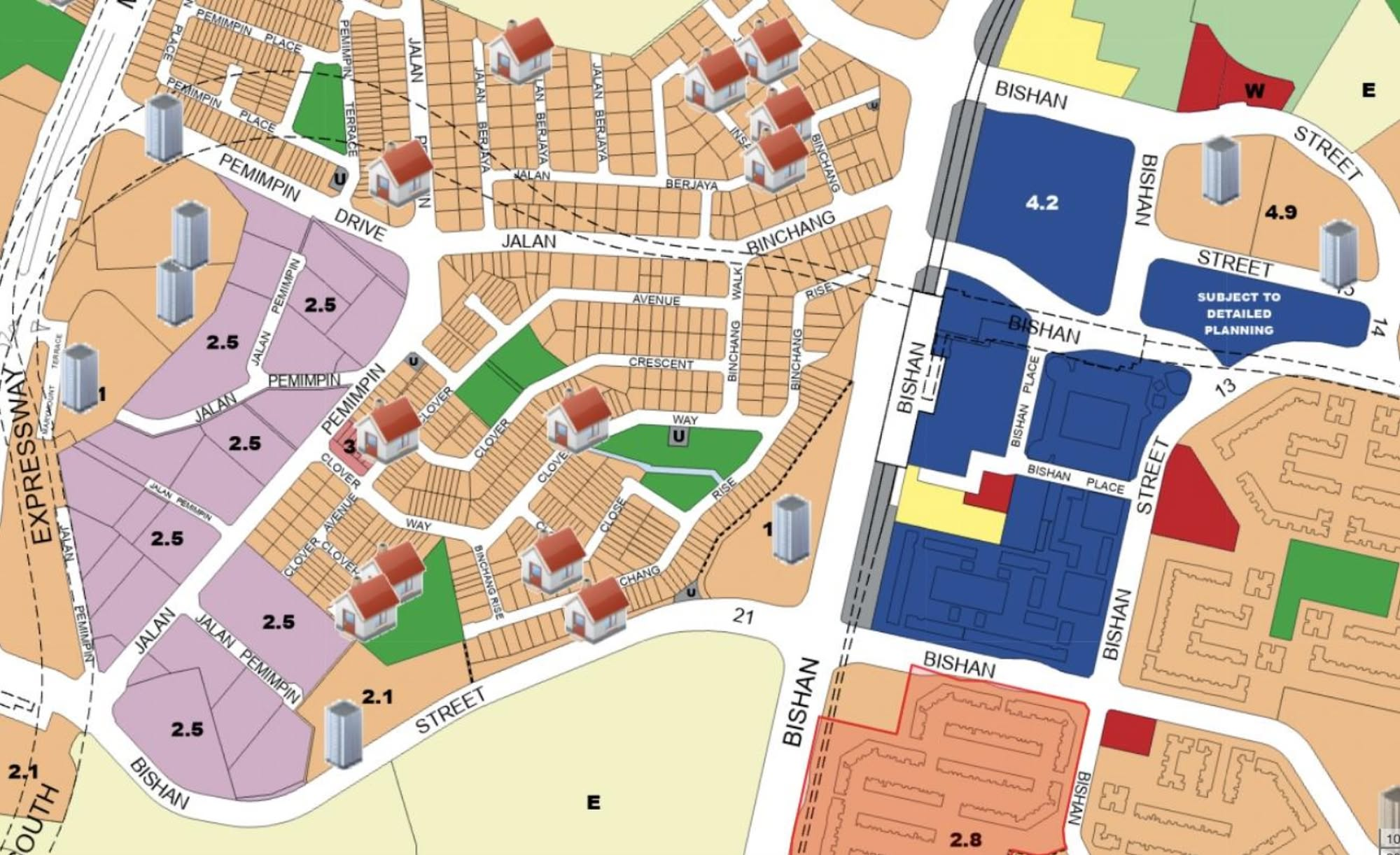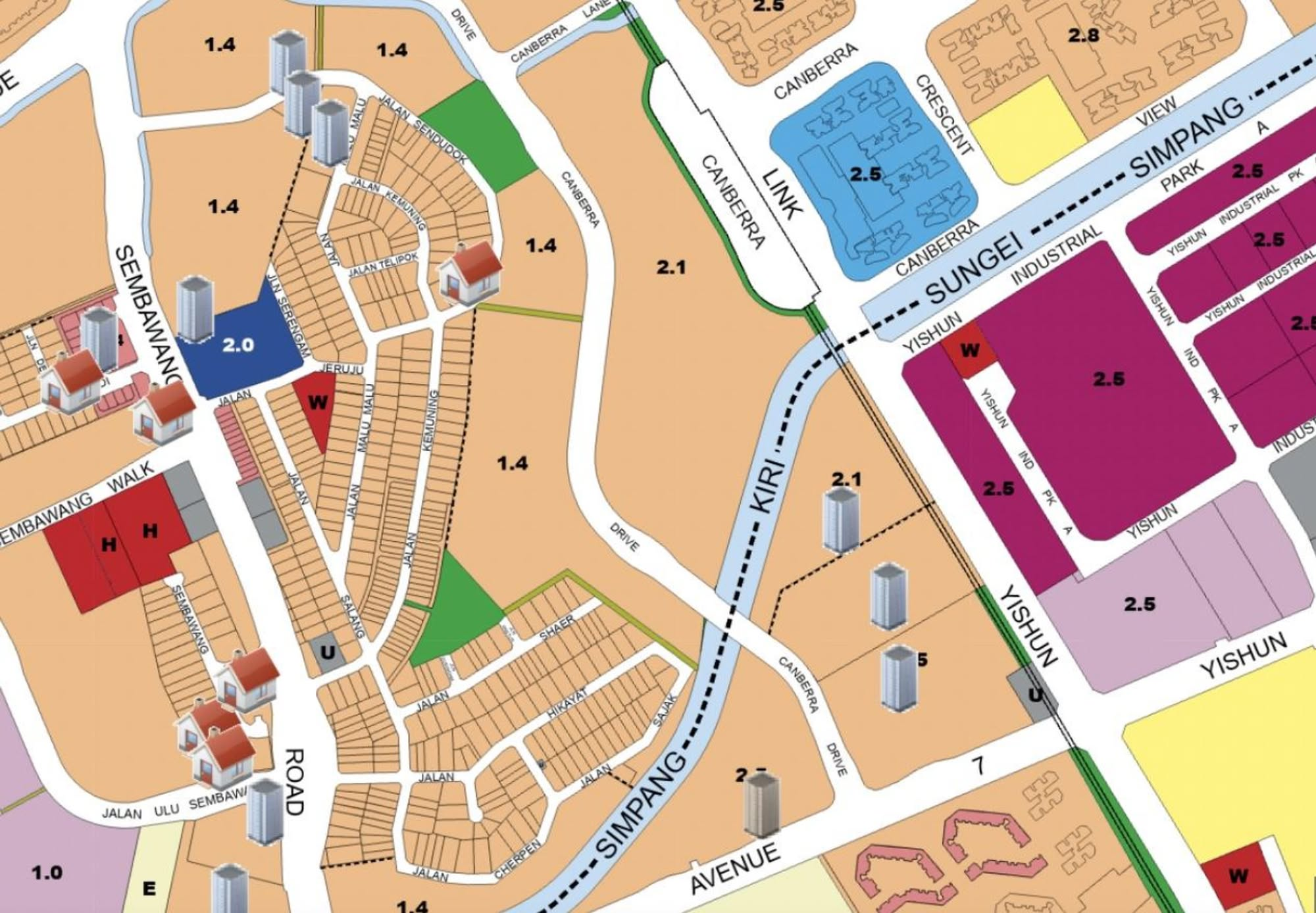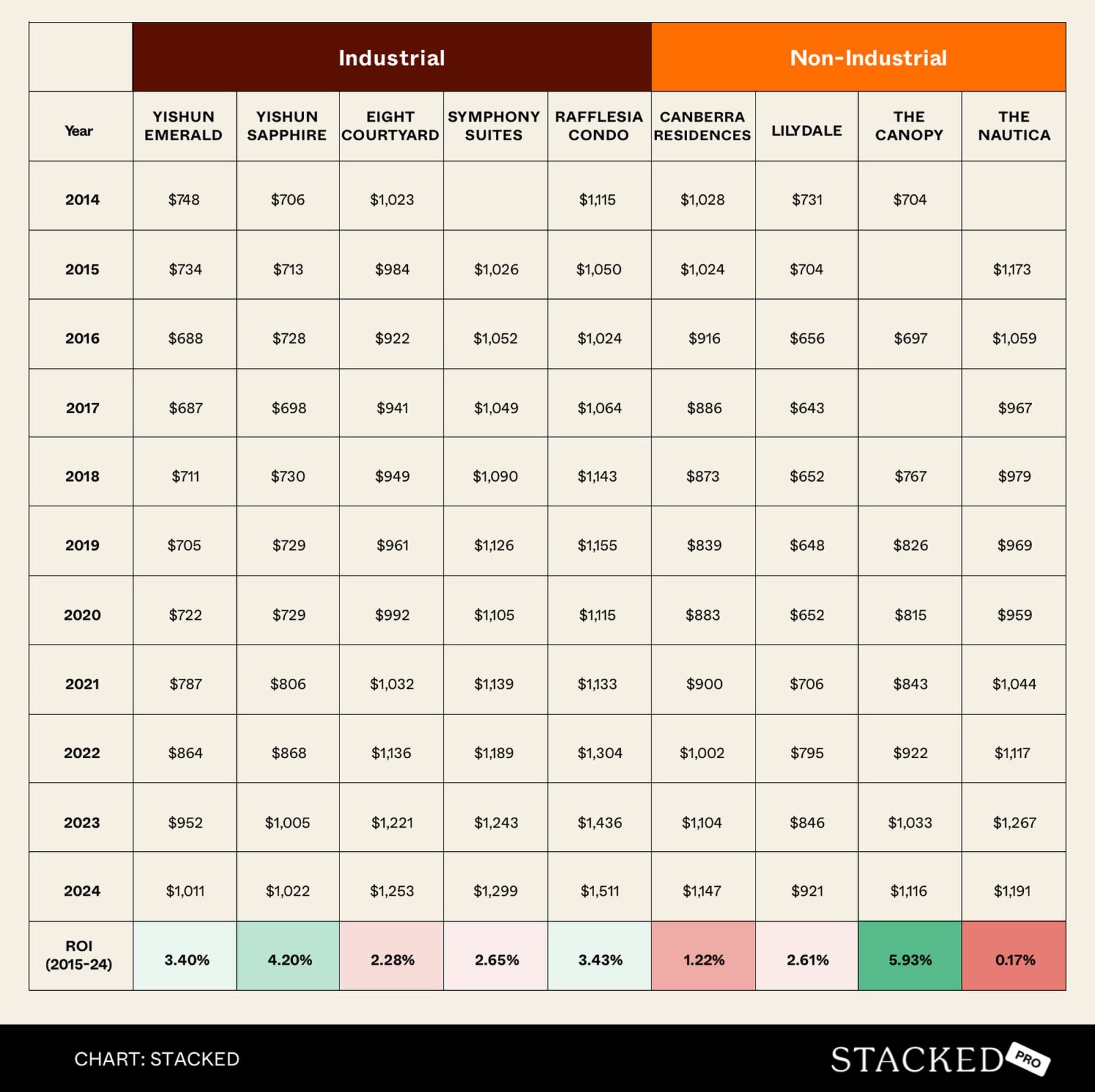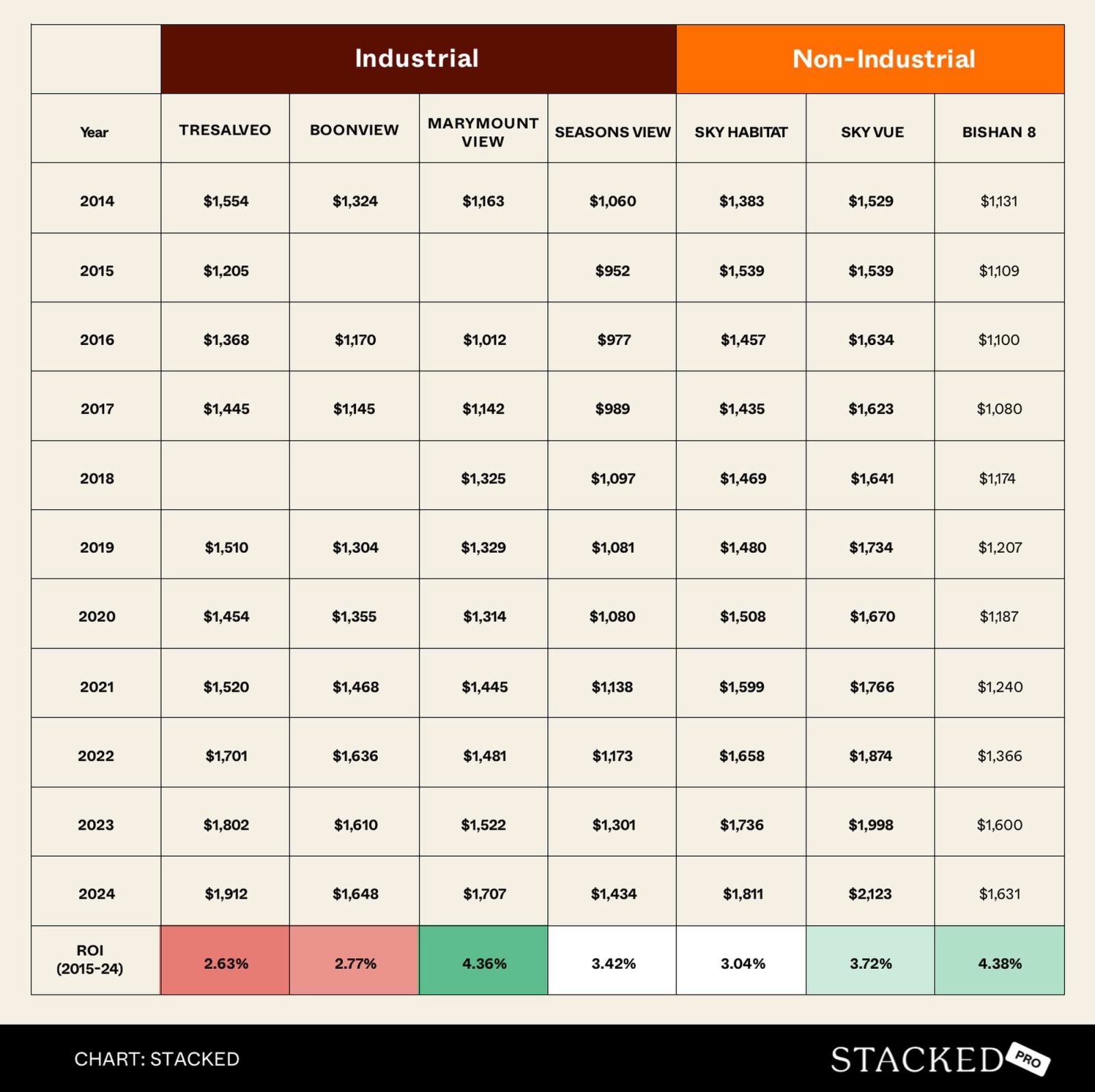In this Stacked Pro breakdown:
- We examined how proximity to light industrial zones affects condo performance in Yishun and Bishan.
- Some developments near these areas defied expectations over a 10-year period.
- The data points to surprising patterns in value and demand — especially for investors.
Already a subscriber? Log in here.
One of the “property facts” most of us assume without question is “nearby industrial areas = bad.” This is a bit simplistic, since not all industrial areas are the same: smog belching heavy industry is actually kept quite far from residential areas, for example, whilst industry near homes tends to be warehouses, materials vendors, etc. Nonetheless, the idea of avoiding industrial areas persists; so let’s take a look at the real data, showing the real impact on housing:
Looking at condos near light industrial areas
For this study, we identified two estates where we could find useful points of comparison: these are Yishun and Bishan. Both these neighbourhoods have a sufficient number of condos that are both near and far from light industrial areas, for fair comparison.
Note that we’ll also be excluding Executive Condominiums (ECs) from our study, as ECs are subsidised at launch and have HDB-like conditions, which would distort the data.
Here’s a look at the area in Bishan:

Meanwhile, here’s the other location in Yishun:

The magenta-coloured plots are industrial, while the beige coloured plots are residential. For a more detailed rundown on how to read the maps, check out our guide here.
Let’s start by looking in the Yishun area
For Yishun, condo projects near the industrial area include Yishun Emerald, Yishun Sapphire, Eight Courtyards, Symphony Suites, and Rafflesia Condominium.
Projects still within Yishun, but far from the industrial area, include Canberra Residences, Lillydale, The Canopy, and The Nautical.
Here’s how their prices have moved over a 10-year period, from 2014 to 2024. We’ve included the overall Return On Investment (ROI) so you can compare:
Note: For Symphony Suites and The Nautical, data was not available for 2014, so we had to make do with 2015 data instead, as the starting point.

Surprisingly, being near the industrial area doesn’t seem to have any negative impact. In fact, if we aggregate their approximate ROI, the condos nearer the industrial area saw around 41.91 per cent over the given period. But the batch further from the industrial areas had an approximate ROI of 21.76 per cent over the same period.
More specifically, Yishun Emerald and Yishun Sapphire pulled off surprise performances. They did well considering our time period started around the last property trough (2014-2015, post-cooling measures). Perhaps it’s because both condos had a relatively low starting price (~$700+ psf in 2015), which allowed for higher percentage gains as the market recovered.
In the other examples, Canberra Residence and The Nautical (further from the industrial area) also seemed to underperform, whilst condos like The Canopy and Bishan 8 did well regardless of proximity to the industrial area.
For Canberra Residences, the surge of new condos in the vicinity (Visionaire, Provence Residence, The Watergardens, and others) could divert attention and demand for Canberra Residences. These newer projects also mean newer facilities and layouts, which provide stronger competition.
Canberra Residences and The Nautical also launched with higher starting prices, which made substantial capital appreciation more difficult. In 2015, Canberra Residences launched at $1,024 psf, while The Nautical started at $1,173 psf, approximately 14.55 per cent higher.
By 2024, Canberra Residences appreciated to $1,147 psf, around a 12 per cent increase, while The Nautical reached $1,191 psf, a 1.53 per cent increase. The modest growth for The Nautical reflects how a higher entry price can limit future upside.
A quick look at profitability
For those who want to look at profitability alone, we need to start from 14th January 2011. This is due to the imposition of the Sellers Stamp Duty (SSD) at this time, which would impact the profitability:
| Project | Area | Type | Average of annualised | Average of % | No. of Tnx | Average of annualised | Average of % | No. of Tnx | % Winners |
| EIGHT COURTYARDS | Yishun | Industrial | 3.2% | 24.7% | 263 | -1.1% | -4.7% | 6 | 97.8% |
| SYMPHONY SUITES | Yishun | Industrial | 2.4% | 15.4% | 201 | -2.5% | -8.7% | 2 | 99.0% |
| YISHUN EMERALD | Yishun | Industrial | 4.8% | 43.7% | 350 | -3.5% | -10.1% | 48 | 87.9% |
| YISHUN SAPPHIRE | Yishun | Industrial | 5.2% | 45.3% | 270 | -3.9% | -12.1% | 47 | 85.2% |
| CANBERRA RESIDENCES | Yishun | Non-Industrial | 2.4% | 16.8% | 146 | -1.1% | -6.1% | 10 | 93.6% |
| LILYDALE | Yishun | Non-Industrial | 5.5% | 48.2% | 389 | -1.5% | -6.1% | 21 | 94.9% |
| THE CANOPY | Yishun | Non-Industrial | 3.5% | 32.5% | 183 | 100.0% | |||
| THE NAUTICAL | Yishun | Non-Industrial | 2.5% | 17.3% | 191 | -0.5% | -2.6% | 9 | 95.5% |
More from Stacked
In this Stacked Pro breakdown:
Ryan J ·
22 Apr 2025 ·
0 comments
The results are in line with what we saw when measuring ROI. Eight Courtyards (97.8 per cent) and Symphony Suites (99 per cent) have nearly all profitable transactions despite their industrial proximity.
Yishun Emerald (87.9 per cent ) and Yishun Sapphire (85.2 per cent) have a slightly lower “winner” percentage, but are still strong. This suggests that industrial area condos didn’t fare worse—they even saw stronger appreciation in many cases.
(That said, we do notice that despite their good overall profitability, Yishun Emerald and Yishun Sapphire coincidentally have the largest proportion of losing transactions between 2011 and 2025.)
From the perspective of some realtors, this may be related to initial price points and the market’s view of Yishun as a more affordable area. One realtor opined that lower starting prices made projects like Yishun Emerald and Yishun Sapphire more appealing to the budget-conscious demographic who buy there. For Canberra/Nautical buyers, there were also other choices in a similar price range.
Another realtor pointed out that certain types of investors, such as those emphasising rental income over resale gains, may have more interest in the projects closer to the industrial areas. These projects have a ready supply of tenants from nearby workers, and are known to have very low vacancy rates.
If the realtors are correct, then factors like entry prices and rental prospects carry much more weight than proximity to the industrial area.
Next, let’s look at the Bishan area
Tresalveo, Boonview, Marymount View and Seasons View are the condos near the industrial area. Further away are Sky Habitat, Sky Vue, and Bishhan 8.

Bishan condos near the industrial areas had a higher approximate ROI (55.33 per cent) compared to those farther from industrial areas (32.91 per cent). Like Yishun, there doesn’t seem to have been a drawback.
Interestingly though, the top performers saw one from each batch: Marymount View (4.36 per cent) was a top performer near the industrial area. Bishan 8 (4.38 per cent) was a top performer, further away from the industrial area. These two may show that proximity to an industrial area has much less impact than we tend to assume.
That said, we do have to take results from Marymount View with the proverbial grain of salt, as it’s a boutique project with only 68 units (the small unit count makes for a more volatile transaction history).
Once again, a quick look at how starting prices made most of the difference:
Sky Vue started at $1,539 psf in 2015 and rose to $2,123 psf in 2024, reflecting a 37.9 per cent increase over nine years.
Sky Habitat started at $1,539 psf in 2015 and rose to $1,811 psf in 2024, for a 17.7 per cent increase.
Bishan 8 started at $1,109 psf in 2015 and rose to $1,631 psf in 2024, translating to a 47.1 per cent increase.
Notice these gains are weaker than the percentage growth seen in lower-priced properties like Marymount View, which appreciated by 79.3 per cent over the same period (from $952 psf to $1,707 psf). So once again, we can see the lower entry price more than compensates for proximity to the industrial zones.
Looking at profitability:
| Project | Area | Type | Average of annualised | Average of % | No. of Tnx | Average of annualised | Average of % | No. of Tnx | % Winners |
| BOONVIEW | Bishan | Industrial | 1.6% | 10.9% | 3 | 100.0% | |||
| MARYMOUNT VIEW | Bishan | Industrial | 3.6% | 33.7% | 7 | 100.0% | |||
| RAFFLESIA CONDOMINIUM | Bishan | Industrial | 3.0% | 19.0% | 26 | -0.8% | -6.0% | 2 | 92.9% |
| SEASONS VIEW | Bishan | Industrial | 3.5% | 32.6% | 21 | -1.4% | -5.7% | 5 | 80.8% |
| TRESALVEO | Bishan | Industrial | 3.3% | 26.3% | 9 | 100.0% | |||
| BISHAN 8 | Bishan | Non-Industrial | 3.8% | 23.3% | 23 | -0.5% | -2.4% | 2 | 92.0% |
| SKY HABITAT | Bishan | Non-Industrial | 2.2% | 17.6% | 102 | -1.4% | -8.4% | 27 | 79.1% |
| SKY VUE | Bishan | Non-Industrial | 3.1% | 22.3% | 229 | -4.6% | -2.8% | 1 | 99.6% |
Timing and launch price factors played a major role for some condos here: Sky Habitat saw the highest percentage of losing transactions (27 losing transactions), but this was potentially due to Sky Habitat having to relaunch at a lower price point.
That said, the condos closer to the industrial area seemed to fare better still, with the exception of Boonview (this is due to Boonview having only three buy/sell transactions).
Overall conclusion:
Being near industrial areas did not negatively impact profitability. In fact, many of the condos near the industrial areas even appear to have performed better. This may be due to factors such as improved rentability or a lower starting price due to the location.
But it’s clear that other factors, such as market positioning, entry price, the number of units, etc., significantly outweigh industrial proximity as a factor. This may also be due to the nature of the light industrial zones found near our homes: Singapore tends to keep the heavy pollution and noise far from residential areas, so homeowners may not care too much.
For specific questions about your property or guidance on making your next property purchase, reach out to us here.








